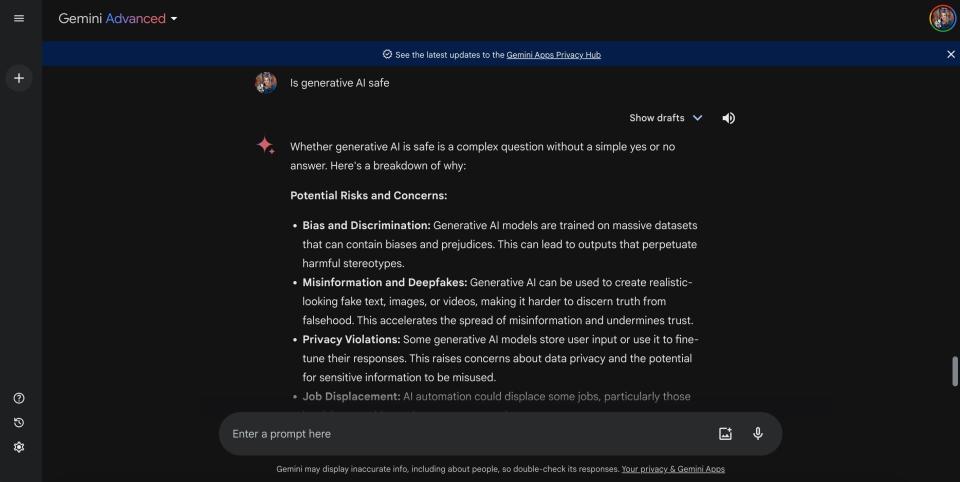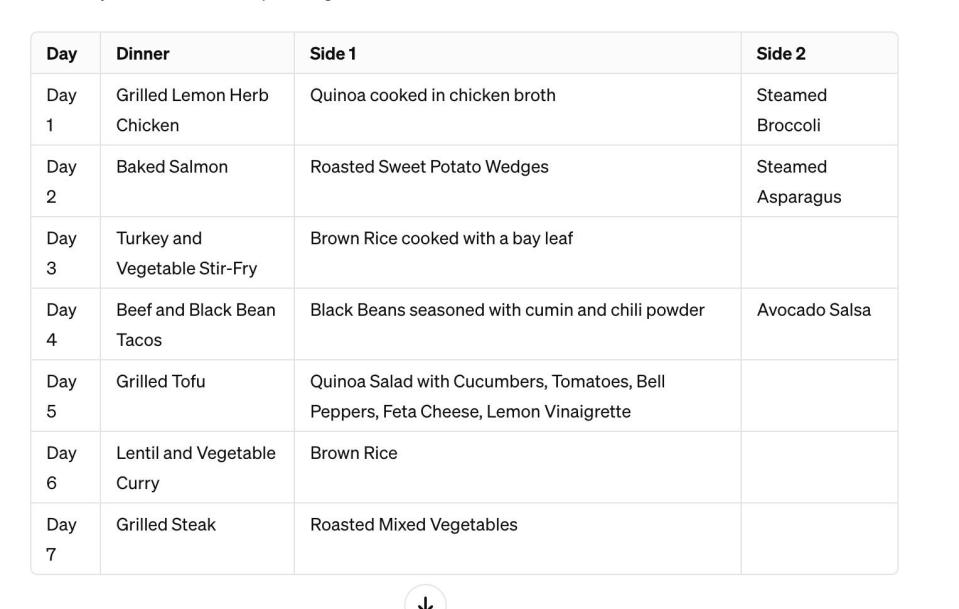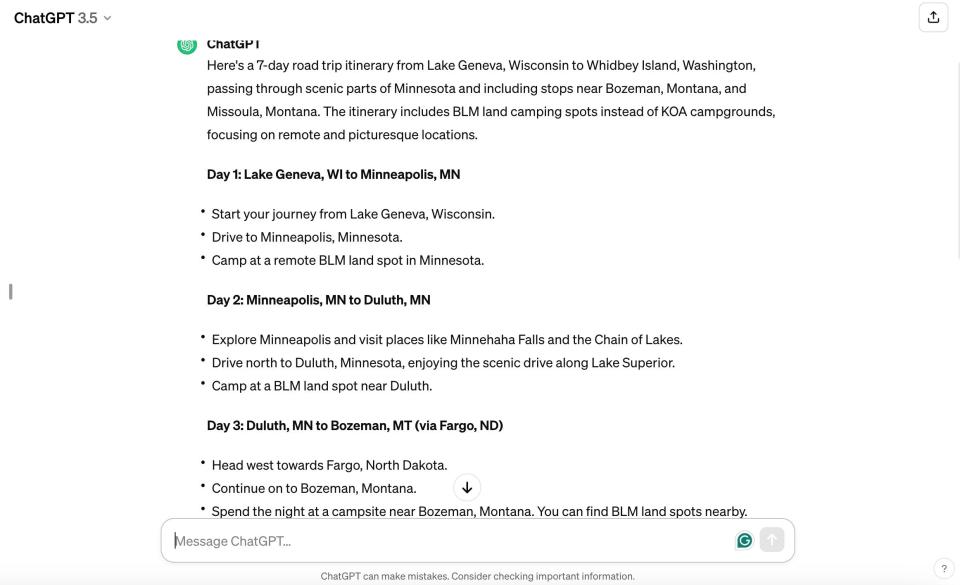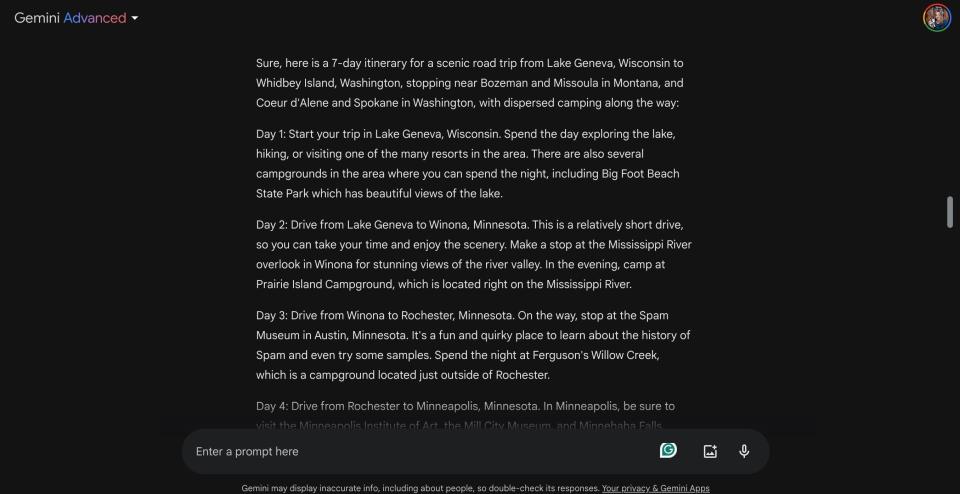Can AI help me pack? Tips for using ChatGPT, other chatbots for daily tasks
Have you used artificial intelligence in your daily life yet? I just asked that question in a room of ten people ranging from 35 to 85 years old.
Only one person – aside from me – had used an AI chatbot like OpenAI’s ChatGPT, Google’s Bard (now renamed Gemini), Bing Chat (now called Copilot), or any of the others that cropped up over the last year.
The person who had used it updated her professional bio through prompts on the free version of ChatGPT. It was short and sweet she said, and did a fine job crafting an adequate professional history for what she needed.
How can I use AI in my daily routine?
My casual little poll of the people in a room aligns with what we’re seeing from many more scientific studies and research nationwide – most people have heard of generative AI, few have used it (that they know of), and a majority of people don’t trust it.
As most chatbots will tell you, it’s good to be skeptical at this point. It’s still really early days for new consumer AI tech tools, and they can be glitchy and filled with misinformation.
As long as you know these limitations going in and incorporate a few pro tips, there are some super helpful ways we can use those tools right now.

Meal Planning
Meal planning is a fan favorite. Tell your AI chatbot what you have in the refrigerator, and let it come back with a recipe. Or use it to help you plan dinners and buy groceries based on dietary restrictions.
You can also do the same thing with cocktails, as I just found out while on vacation in Costa Rica.
My niece, Megan Blelloch, 27, says meal planning is “the most helpful way to use AI right now.” Blelloch says she uses AI to suggest meals too.
“I have ChatGPT find recipes … or I'll import my spreadsheet of cataloged recipes,'' she says. "You can also use anything found online with the right prompt, such as ‘Prepare a week's worth of healthy three-course meals with recipes from Ina Garten,’ and it should populate a good answer. Then, you can have it populate a chart and a grocery list, organized by category.”

Nicole Mora, a 46-year-old communications professional, agrees AI chatbots can be a big help when health concerns are involved too.
“I use it because my mother-in-law has three different health conditions/autoimmune issues and is limited (in) things she can eat. So, I put in the three conditions and asked what foods are safe, then asked for recipes and a shopping list.”
Also, if you ask ChatGPT to provide this information in “table format,” it generates a nice list you can use for other programs like Microsoft Excel.

PRO TIP: You might not get good results with recipes if you ask a vague or confusing question. Use prompts that sound like you’re talking with a real person and make them as detailed as possible with your personal preferences.
For example, instead of asking for “a recipe for chicken,” say, "Can you give me a recipe for quick Thai curry chicken that uses coconut milk, tofu, and whatever vegetables are in season? I'm an intermediate cook looking for something I can make in under 30 minutes using a single pot.”
Trip planning
Did I mention I was recently in Costa Rica? I used Copilot to generate a last-minute packing list to whittle down my overstuffed luggage while not forgetting anything important. It reminded me to take mosquito repellent, my open-water swim goggles and to leave my jacket and dress shoes behind.
This isn’t earth-shattering, but it did the job I needed it to do quickly and efficiently. Five days into my 10-day trip, I felt really good about not overpacking (for a change), yet still having everything I needed.
Blelloch also uses it quite a bit for travel ideas. “I did a test run for our five-day trip to London in July, and it was pretty close to our actual itinerary,'' she says. "The restaurant recs were pretty good (and can be tailored based on price and preference), so if you are going somewhere new and have no idea where to start, give AI a chance. It can recommend literally everything.”
PRO TIP: Have you heard about AI’s “hallucination” problem? That’s when AI makes up something but presents it as a fact.
That happened when I tried ChatGPT to help with a camping-based road trip itinerary last fall. It failed miserably, especially when asked to locate dispersed camping on BLM land, which was my main reason for using it.

I’ve recently gotten much better results using paid versions of all three of my go-to’s – ChatGPT4, Gemini, and Copilot, and asking the chatbots to incorporate suggestions from trusted travel sites such as Lonely Planet, The Points Guy, and Outside Magazine (specifically because I like more adventure travel). Each chatbot costs about $20 a month after a free trial period.

Job interviewing
As much as we fear losing jobs to AI, Blelloch says chatbots have been incredibly useful on the job-hunter side too. “When I was interviewing for jobs, I cut and pasted the job description and my resume into ChatGPT and had AI create a list of interview questions. It was really helpful because (the potential questions) were tailored to the position and my resume.”
Blelloch also used ChatGPT to help with an early first draft of a cover letter and to critique her resume based on specific job descriptions. “These needed heavy editing, obviously,” she added, “but they used all the keywords that an AI would look for on the receiving end, and I got more interviews than I did when I was writing cover letters (from scratch).”
PRO TIP: Be sure to try out your job interview responses with your AI chatbot and ask it to rate your responses as if it were the hiring manager.
Don’t memorize the AI responses because they aren’t human (duh), but instead use them to help brainstorm and practice. That way, when you get the inevitable question, “What’s your biggest weakness?” you’ll have a better answer than, “I work too hard.”
Creating family activities
AI chatbots tend to be good at brainstorming and bad at “facts.” Still, it’s excellent for developing new ways to engage, entertain, and educate kids.
Last summer, San Diego PR strategist Lorena Ruggero used ChatGPT to create a “golden hour” curriculum for her 12-year-old son.
“He's academically advanced, and I wanted to keep him engaged in something mentally stimulating instead of playing video games and watching YouTube all day,” Ruggero explained.
Her son's teacher recommended a “golden hour” plan, which is the idea behind helping students pursue a topic they're interested in for an hour each day. “He shared some interest in stop-motion animation with Legos and his iPad, so I used OpenAI to create an eight-week ‘golden hour’ curriculum for him to learn how to create a stop-motion Lego film,” Ruggero said.
Along these same lines, chatbots are solid for helping you write code or for grammar checks. It does best with creativity and worse with factual information. Like any tool, you must learn to use it. It will only go well if you know what you're doing.
PRO TIP: Use your chatbot to write and create with you versus for you.
Your chatbot gets better the more it learns from you over time. If you don’t get the results you want with the first prompt, give it more information and keep asking. If you’re creating a curriculum for a specific child or even using it to help you write a speech, ask it to “interview” you to get all of the information it needs to do the best job it can. In other words, help the tool help you.
It’s a new way to think using your tech – and it actually works.
Arguing and negotiation
My family has a lot of “spirited debates.” These aren’t contentious arguments by any stretch but rather conversations around topics we have a lot of feelings about. Like sunscreen.
On the family trip to Costa Rica, one of my relatives argued that “child-safe sunscreen” with zinc oxide is bad for toddlers, full stop. My position was that it’s better than a sunburn. Simple, right?
Clearly, you’ve not been in one of my family discussions.
To have a more productive conversation around this issue without getting mad about it, I needed a few specific talking points to help get my point across without attacking, upsetting, or alienating my family members. (I’m not always good about that last part.)
I used a ChatGPT plug-in tool called Negotiator to help create some compelling points in favor of sunscreen while not getting too emotional around the debate.
Remember, chatbots can be great for ideas and bad for facts, so I used other sources for scientific research and medical guidelines. But this was a fabulous tool for helping me establish the tone and concise points that could help me win the latest family debate without ruffling feathers.
PRO TIP: This example might be a stretch for most people, but think of using this to help with negotiating a salary raise, work exit strategy, car purchase, or something else you care about and need to advocate for.
Jennifer Jolly is an Emmy Award-winning consumer tech columnist and on-air correspondent.
The views and opinions expressed in this column are the author's and do not necessarily reflect those of USA TODAY.
Contact her at JJ@Techish.com.
This article originally appeared on USA TODAY: Chat GPT, what's for dinner? AI can help plan meals and other tasks

